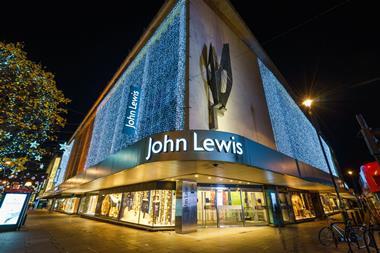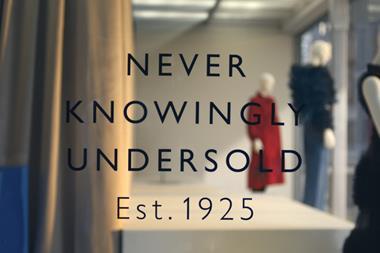Bullring was hailed as Europe’s largest city centre, retail-led, urban renewal project when it opened in 2003. Laura Heywood finds out what changes have taken place over a turbulent decade.

Choked by the ‘concrete collar’ of Birmingham’s elevated inner ring road, the Bullring of the 1990s was a soulless shopping centre plagued by vacant units and temporary stores, and characterised by ugly urban architecture.
Isolated from the rest of the city, the shopping centre had ceased being a place where locals chose to go, or big retailers chose to take space.
“Bullring was inhospitable and cold, aggressive in its design and brutal looking. People hadn’t shopped in Birmingham for many years - it had been out of bounds to many for 10-to-15 years,” recalls David Atkins, chief executive of retail property giant Hammerson which, in 1996, purchased the failing centre and 26-acre site.
Three years later in February 1999, the Birmingham Alliance was formed − a partnership between Hammerson, Land Securities and Henderson Global Investors − to carry out Europe’s largest city centre regeneration project.
Despite the huge expense involved − the regeneration is thought to have cost in excess of £600m − Hammerson’s aims were simple. “We wanted to extinguish all the negatives of the past and start again, and try to think ahead in terms of design, flexibility of the space and the way the scheme integrates with the city,” Atkins says.
At the time, the bulk of retail property development was in out-of-town malls “that didn’t have a community around them”, according to Atkins, marking Bullring out as a different type of project. “It was the first truly transformational, large-scale regeneration project of a city centre. The building work linked [retail in] Birmingham back to the heart of the city and generally transformed the cityscape,” Atkins says.
But with the centre so far from the thriving retail and leisure hub of London, Birmingham was unproven as a retail destination.
Getting anchor store Selfridges on board “set the tone” for other retailers to follow suit, according to Atkins, as Selfridges took 270,000 sq ft of space in one of its first major stores outside London. “That brought more brands into the city, who gained confidence [from the Selfridges signing],” Atkins says.
Debenhams was secured as the second anchor - its new flagship department store marked the retailer’s return to Birmingham after a 20-year absence.
Both signings enabled Hammerson to introduce variety into Bullring’s offering, according to Atkins. “Debenhams was well known and well recognised on many high streets, whereas Selfridges was seen as a London-focused, luxury retailer,” he says.
The general slowdown in availability of new retail property space and lack of development in the UK also meant demand for space was high. “There was pent up demand,” he adds, and Bullring’s leasing was ahead of all Hammerson’s previous developments.
In fact, it was the shoppers that Hammerson had a harder time persuading about the viability of the new centre. “It took a little while for the consumer to understand the level that Bullring was pitched.” That level included offering a core of aspirational, luxury names that had previously been absent from the city. “There was a re-education that had to take place,” Atkins says, and rolling out a direct marketing programme became an early priority.
However, despite a 97% let rate on opening day, the early days weren’t all plain sailing. Some retailers, such as John Lewis, chose to take space in the nearby, more established town of Solihull. “Opening a store then in Birmingham city centre would have been a leap of faith [for John Lewis],” Atkins admits. “But now 10 years later if there was uncertainty or reticence, it’s gone.”
Despite being an untested and unproven shopping destination, retailers of all sizes and nationalities were attracted to the centre and 57 of the retailers on opening day were new to the city.
“Confidence was gained from the success of others,” Atkins admits, as Hollister and Apple chose Bullring to open some of their first stores in the UK and Forever 21 opened its first European store.
Love from the locals
The financial success of the scheme has surpassed expectations, Atkins maintains, and rents have risen at 5% per annum since it opened.
The community has also been central to Bullring’s success, according to Atkins, who talks at great length about locals’ love of the shopping centre. “Bullring is at the heart of the community and the city - it defines Birmingham. It’s so important because the shopping centre is so much more than a retail destination. It’s a place to meet people, socialise and spend your leisure time. It’s become a place that people naturally think to go to.”
The provision of catering has been one of the major changes the centre has undergone in its 10-year history. “When we opened there’s no doubt that people ate out less. There wasn’t the mindset that to go out for a fairly classy evening meal you could go to a shopping centre.”
But while leisure has become a more prominent part of the centre, Atkins would like to see it become even bigger. “I’d love to bring a cinema complex to the scheme,” he reveals, and he predicts Bullring’s service provision “will continue to improve”, with the introduction of facilities such as concierge desks and improved click-and-collect areas.
Atkins expects that technology will play a growing part in the centre. He predicts the introduction of a number of technological initiatives that could help improve customers’ experiences in such areas as travel and transport. “We’re also trialling loyalty programmes in other centres - if successful it will come to Bullring,” he adds.
This May, Hammerson signalled its ongoing commitment to Bullring when it acquired an additional 16.7% stake in the shopping centre, taking its ownership to 50% in a joint venture with Canada Pension Plan Investment Board.
With a decade of management already under its belt, Hammerson has proven it can attract leading domestic brands, expanding international retailers and first-class catering to Birmingham. And with its future stake in the centre now secured, Hammerson is on a mission to cement Bullring’s position as one of the UK’s strongest shopping destinations in the decade to come.
Atkins’ viewpoint
Biggest challenge in the past decade:“Adapting the centre to a multichannel environment, with demands such as free wi-fi. Social interaction is now part of what people do - they want full connectivity or they just won’t come.”
Biggest change in the past decade:“We’ve done a huge amount of rightsizing and introducing new fascias. The real change is through the retailers and brands themselves. They set the pace in massive ways and it will continue to evolve.”
Biggest achievement in the past decade:“Bullring has stood the test of time. It’s very well known and it really
did change the landscape.”
Biggest prediction for the next decade:“A major Chinese brand will have a store in every shopping centre in
the UK.”
Comment
- Pradera managing director Neil Varnham, who led the asset management team that redeveloped the Bullring while at Henderson Global Investors, assesses Bullring’s success
“Having been one of the instigators and creators behind one of the largest joint ventures between two of the top property companies and a fund manager, I look back on Bullring’s 10-year history with pride and interest.
“It has undoubtedly taken its rightful position as the premier retail location in the second city and a beacon for international accolades and study tours. Its success is undoubted, but trying to convince Selfridges in those early days and at the same time trying to understand if 26,000 spun aluminium dishes on the outside of a building based on the 1960’s design of a Paco Rabanne dress was the correct decision, took some digesting.
“Those early days were a struggle in attracting restaurant groups, fast-food operators and the like. Looking back today the demand is now there for much more food and this is probably the biggest single change in how Bullring has changed and the marketplace has evolved over the same period. The evolution of the retail mix has proved to be undertaken well, and the marketing techniques have continued to evolve from day one, to attain a class-leading approach.
“History will show that knocking down a 1960s shopping centre and replacing it with a new scheme was the right decision, and one which should be looked at in other locations around the UK and Europe.”


























No comments yet